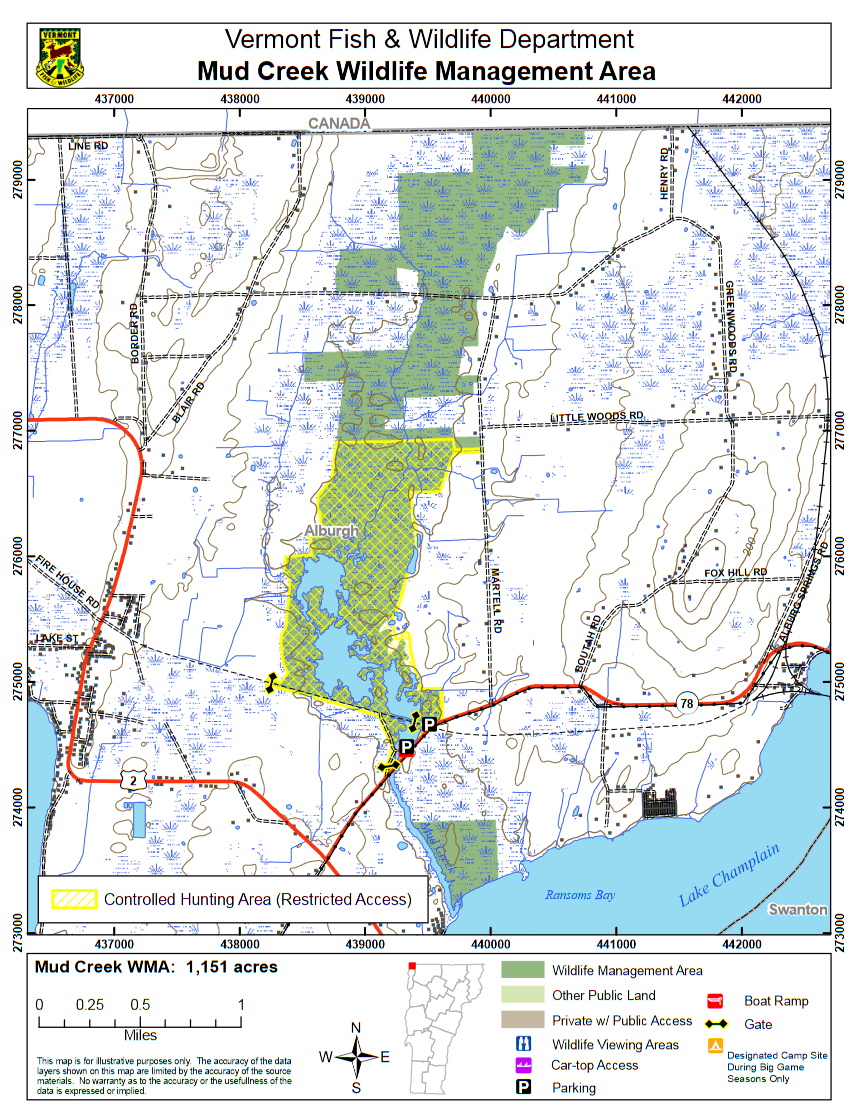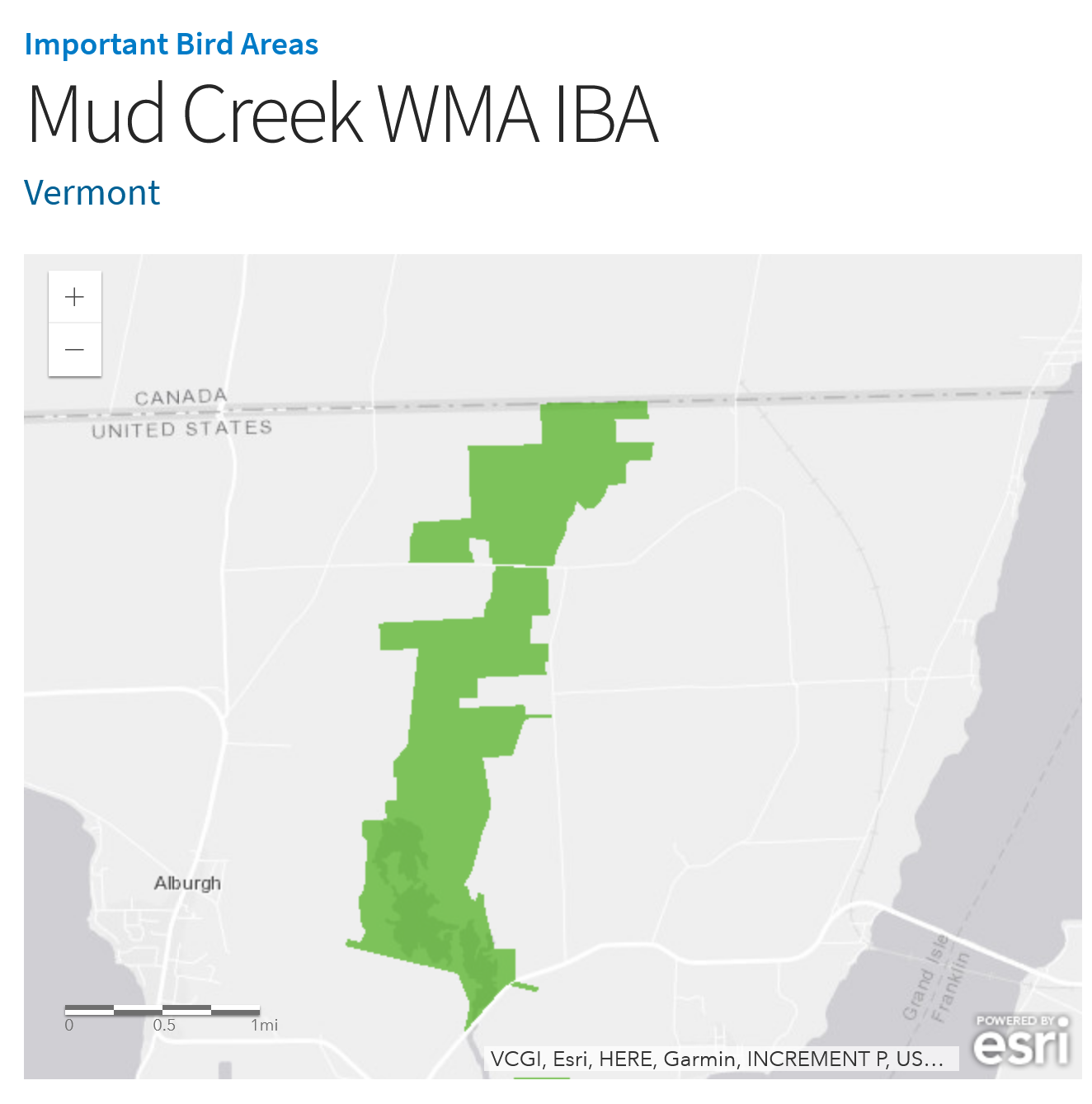Mud Creek WMA IBA
Mud Creek WMA IBA
Alburg, Vermont 05440
Mud Creek Wildlife Management Area guide and mapMud Creek Wildlife Management Area IBA (Audubon) webpage
Tips for Birding
Birdwatching in Vermont, pp. 41-42
The name Mud Creek may not sound particularly inviting when it comes to birding, but, believe me, the Mud Creek WMA in Alburg is one of Vermont’s premier birding spots. Interestingly, if you go to Vermont eBird and look at the checklist for the Mud Creek WMA “hotspot”, the species list is quite modest-65 species or so. But note, also, that the number of data entries on this list is very small, reflecting the fact that Mud Creek is seldom visited even by the experienced birders who contribute their findings to VT eBird. If you go to the Vermont Fish and Wildlife account of birdlife in this refuge there are a number of species that do not appear on the Vermont eBird list such as Virginia Rail, Sora, Black Tern, and Least Bittern. Without promising that you will see any of these species, my take is that the Mud Creek WMA is visited infrequently and underappreciated by birders. I don’t think we know for sure all of the species that reside there, breed there, or pass through there in migration. Here is an opportunity for some exploration and some fun.
The easiest way to get to Mud Creek WMA is to follow Route 2 through the Champlain Islands until you reach Route 78 in Alburg. Turn right on Route 78 and drive about a mile to a small parking lot on the left. The main trail is the old Rutland Railroad roadbed, which is elevated above the marsh. As Ken Copenhaver points out, you can walk through the swamp without getting your feet wet. Serious Vermont birders will want to visit the Mud Creek WMA. If you go, bring your spotting scope for an optimal birding experience.
Birds of Interest
In addition to being a nesting area for state-threatened Black Terns, it is also a breeding site for Least Bittern, Common Moorhen, Virginia Rail, and Sora. Mud Creek WMA’s location within the Champlain Basin and its close proximity to Lake Champlain makes it an ideal stopping place for waterfowl including large numbers of Ring-necked Duck, Green-winged Teal, and Black Duck with the latter two species breeding here. The associated forests support a number of common Vermont land bird species including Yellow Warbler, Warbling Vireo, Wood Thrush, and Grey Catbird. During periods of low lake levels exposed mudflats attract a number of shorebirds.
Excellent birding opportunities exist for wetland species such as Pied-billed Grebe, Least Bittern, Sora, Virginia Rail, American Coot, and Common Gallinule. The endangered Black Tern has nested here. Wetland-dwelling songbirds include Eastern Kingbird, Belted Kingfisher, Marsh Wren, Swamp Sparrow, and Northern Waterthrush. Upland game species in the WMA are Ruffed Grouse, Turkey, and Woodcock. Breeding waterfowl include Canada Goose, Black and Wood Ducks, Mallard, Hooded Merganser, Blue-winged Teal, and Goldeneye, with other species during migration.
About Mud Creek Wildlife Management Area
See all hotspots at Mud Creek Wildlife Management Area
Mud Creek Wildlife Management Area (WMA) is located in the northwestern corner of Vermont in the town of Alburg. It is mostly marshland, with a small upland component. Its 1,151 acres are owned by the State of Vermont and managed by the Vermont Fish & Wildlife Department. The property extends from the Canadian border south to Mud Creek’s mouth in Ransoms Bay in Lake Champlain. The best access is from VT-78 as it crosses the Creek, where there is an old railroad bed that has been made into a biking and hiking path. There are times when access along the path is restricted. Please read and follow the posted regulations.
Green Woods Road in Alburg cuts through the northern end of the WMA. The heart of the marsh can only be accessed by small boats. Hunting in the Controlled Hunting Area is by permit only.
The area around Alburg and Swanton has a long history of occupation by Native Americans, notably by members of the Abenaki Tribe. Both Anglo-Europeans and French Canadians later settled in this part of Vermont. Alburg was chartered to Ira Allen in 1781; the town was named after him. Early settlers were mostly occupied with clearing forests and farming in the rich Champlain Valley soils; the latter is still the main land use in the Mud Creek drainage.
This WMA is a patchwork of many small land purchases. The Vermont Fish and Wildlife Department made its first acquisition in 1953, using Pitman Robertson funds. These funds, which are generated by a tax on firearms and ammunition, have been used for many subsequent purchases. State funding generated from the sale of hunting licenses has been used as well. The Nature Conservancy facilitated some of the most recent land acquisitions.
Mud Creek is a sluggish stream that arises in Canada and flows south to Lake Champlain. There is a water control structure that has raised the water level and created more marshland. The WMA is a mix of cattail-dominated emergent marsh, deep bulrush marshes, and forested swamps. Forestswamp communities include red maple-black ash, spruce-fir-tamarack, and red maple-northern white cedar. Right at the mouth of the Creek, there is a small section of lake sand beach. A rare plant called Torrey’s rush occurs in the marsh, as well as other interesting plants such as matted spike-rush, yellow water-crowfoot, nodding trillium, and cattail sedge. The State-endangered spiny softshell turtle is sometimes a summer visitor.
Features
Restrooms on site
Wheelchair accessible trail
Entrance fee
Roadside viewing
Content from Mud Creek Wildlife Management Area guide and map, Mud Creek Wildlife Management Area IBA (Audubon) webpage, and Bruce MacPherson, Green Mountain Audubon Society
Last updated December 3, 2023

